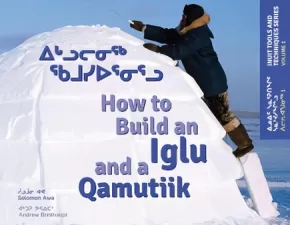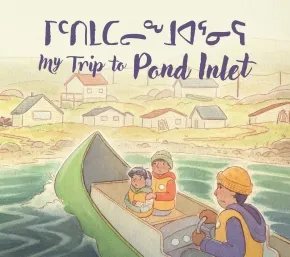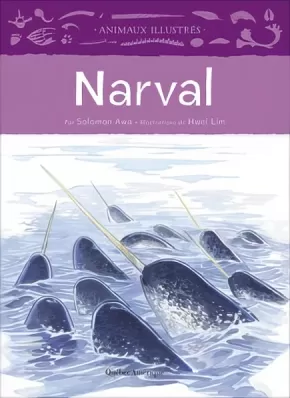Solomon Awa
Solomon Awa was born in a sod house near Iglulik on November 2, 1959. From a young age, he was curious about everything around him. He learned to sew traditional items such as sealskins from his late mother, Appia Awa. His late father, Mathias Awa, was an excellent carver, especially with ivory, and one time he made a harpoon from caribou antlers in one night! Solomon learned to carve from him. Solomon loves to tell the stories that he learned from his father. He does this at schools, and also had the opportunity to go to Kaotokeno, Norway, to tell some of these stories. He teaches traditional knowledge at Nunavut Arctic College and works for the Qikiqtani Inuit Association.
Books (1)
Synopsis:
Based on an Inuit traditional story passed down orally for generations, The Cannibal tells the horrific tale of a family experiencing starvation when the animals they rely on for survival disappear. While the wife stays alive by eating plants she gathers daily, the husband does the unthinkable, resorting to murder and cannibalism. Horrified, and terrified for her life, the wife eventually finds herself alone in camp with her husband. She knows what will happen to her if she does not find a way to escape. Hatching a plan, the exhausted wife embarks on the journey with her murderous husband in pursuit. After safely arriving at a nearby camp, she shares the story of what has become of her camp, and her own children. Soon the husband arrives, and the camp must decide how to deal with the cannibal. Both horrific and poignant, this cautionary traditional story provides a window into the at times harsh realities of traditional life.
Reviews
"The Cannibal by Solomon Awa and Louise Flaherty is a stark and compelling novel centred on an Inuit family facing extreme survival challenges in the Arctic. When the family’s father, driven by desperation, begins to resort to cannibalism to stay alive, the story delves into harrowing themes of survival, morality, and the impact of isolation on human behaviour. This topic is suitable for an older audience, not younger students." - David D., Indigenous Educator & Administrator, Indigenous Books for Schools
Educator Information
The publisher labels this work as an "Adult Graphic Novel."
Recommended in the Indigenous Books for Schools catalogue as a valuable resource for grades 10 to 12 for English Language Arts and Social Studies.
Themes: Animals, Death, Environment, Loss, Reconciliation
Caution: Contains cannibalism
Additional Information
44 pages | 7.00" x 10.50" | Paperback
Kids Books (4)
Synopsis:
Animals Illustrated mixes fun-filled animal facts suitable for the youngest of readers with intricately detailed illustrations to create a unique and beautiful collection of children's non-fiction books on Arctic animals. Each volume contains first-hand accounts from authors who live in the Arctic, along with interesting facts on the behaviours and biology of each animal.
Kids will learn about how narwhal raise their young in the cold Arctic ocean, what they eat, and where they can be found, along with other interested information, like the fact that a narwhals long tusk is actually a tooth!
Reviews
“Narwhal is definitely recommended for school libraries and classroom collections.” — CM Magazine
“The table of contents gives a clear sense of organization. The illustrations are both scientifically accurate, engaging, and beautiful.” — Kid Lit North
“. . . [I]ncludes comment about the narwhal’s deep diving and behaviour beneath the ice, as well as about its impressive tooth, often referred to as a tusk, that can grow up to almost 3 metres in length.” — CanLit for Little Canadians
Educator & Series Information
This book is part of the non-fiction Animals Illustrated series, which mixes fun-filled animal facts suitable for the youngest of readers with intricately detailed illustrations to create a unique and beautiful collection of children’s non-fiction books on Arctic animals. Each volume contains firsthand accounts from authors who live in the Arctic, along with interesting facts on the behaviours and biology of each animal.
Recommended Ages: 5-7
This book is available in French: Narval
Additional Information
24 pages | 6.75" x 9.25"
Synopsis:
The iglu, a traditional winter shelter built in the Arctic for centuries, is a vital part of Inuit culture. The qamutiik, a traditional sled used for hunting, is an essential tool whose versatility and dependability have allowed it to endure over time.
In How to Build an Iglu & a Qamutiik, Solomon Awa provides thorough how-to instructions on building iglus and qamutiiks, along with general background information on their construction and importance to survival. Complete with detailed, clear illustrations, this valuable resource will teach readers to build these structures that are so central to Inuit culture and tradition.
Educator Information
Delivered in a dual-language format of English and Ikutitut.
Additional Information
32 pages | 9.00" x 7.00" | b&w illustrations, colour photographs
Synopsis:
One rainy day, Solomon is playing inside with his sister. Their mom is cooking polar bear meat in a big pot of water. Suddenly, he trips and burns his arm in the pot of boiling water! The burn is so bad that he must travel to the health centre in the neighbouring community of Pond Inlet. Solomon has to stay in Pond Inlet until his arm heals. Even though Solomon misses his home, he likes playing with the other kids at the health centre and exploring the new and exciting community of Pond Inlet.
Educator & Series Information
Recommended for ages 5 to 7.
In My Trip to Pond Inlet children learn about the responsibility of being safe around hot water and taking care of themselves after an injury.
Dual-Language: English and Inuktitut
This book is part of the Community Connections series.
Additional Information
40 pages | 9.00" x 10.00" | Paperback
Synopsis:
La série de livres pédagogiques Animaux illustrés combine des informations fascinantes sur les animaux de l’Arctique, qui s’adressent aux très jeunes lecteurs, avec des illustrations minutieusement détaillées. Chaque volume contient des récits de première main par des auteurs qui habitent dans l’Arctique, ainsi que des faits intéressants sur le comportement et la biologie de chaque animal.
Educator & Series Information
La série de livres pédagogiques Animaux illustrés combine des informations fascinantes sur les animaux de l’Arctique, qui s’adressent aux très jeunes lecteurs, avec des illustrations minutieusement détaillées.
This book is available in English: Narwhal











